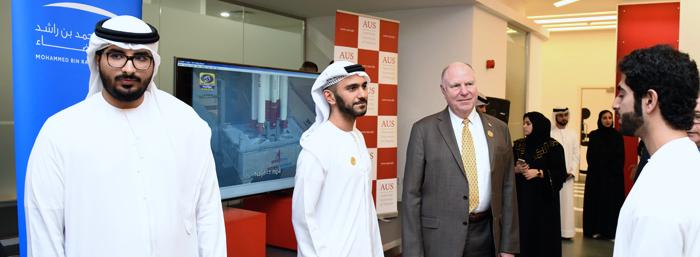- About
- Admissions
- Study at AUS
- Prospective Students
- Bachelor's Degrees
- Master's Degrees
- Doctoral Degrees
- Admission Publications
- International Students
- Contact Admissions
- Grants and Scholarships
- Sponsorship Liaison Services
- Testing Center
- New Student Guide
- File Completion
- New Student Orientation
- Payment Guide
- Executive Education
- Students with Disabilities
- Academics
- Life at AUS
- Research
- Contact Us
- Apply Now
- .

Nayif-1, the UAE's first nanosatellite developed by AUS students and MBRSC, successfully launched into space
Nayif-1, the UAE's first nanosatellite developed by Emirati engineering students from American University of Sharjah (AUS) and the Mohammed bin Rashid Space Center (MBRSC), was successfully launched on February 15, at 7:58 a.m. in the morning (UAE local time).
Nayif-1 was on board a Polar Satellite Launch Vehicle (PSLV-C37) which was launched from the Satish Dhawan Space Center in Sriharikota, India. The PSLV-C37 held around 104 satellites, making it historically the highest number of satellites to be launched together. Nayif-1 was the fifth satellite separated from the launch vehicle after the main payload.
The launch was celebrated at a special event held at the AUS Student Center yesterday and attended by officials from AUS, MBRSC as well as faculty members and students.
Nayif-1 takes on added importance as an educational project launched by MBRSC in cooperation with AUS with the goal of providing hands-on experience to Emirati engineering students on designing, building, testing and operating nanosatellites. It was developed by seven students from AUS, guided by faculty members from the AUS College of Engineering, along with a team of engineers and specialists from MBRSC. It will be monitored from a ground station located at AUS.
"His Highness Sheikh Dr. Sultan bin Muhammad Al Qasimi, UAE Supreme Council Member, Ruler of Sharjah and President of AUS, set up the university as an institution dedicated to the pursuit of excellence in academia and research," said Dr. Björn Kjerfve, Chancellor of AUS. "The successful launch of Nayif-1 is a reflection of that vision and a proud moment for AUS, considering the important part played in its development by seven Emirati students from AUS. The nanosatellite will be monitored by the ground station based at AUS. We are very pleased to have developed this project with MBRSC and look forward to future collaborations that will advance the skills and knowledge of AUS Emirati engineers in space technologies," he added.
Nayif-1's main mission objective is to send and receive messages on Amateur Radio frequencies. It has a number of advanced features, most notably that it is programmed to transfer messages in Arabic. It also holds an Active Control System Board that has not been launched into space before.
Weighing at about 1.32 kg, Nayif-1 was launched into a sun synchronous orbit at an altitude around 512 kilometres above the Earth. During the one to two years the nanosatellite is expected to be in orbit, it is anticipated to pass over the UAE four times per day (two in the morning and two in the evening) where communications with the AUS ground station will take place. It will be visible in the UAE for 10 to 20 minutes on each pass.

